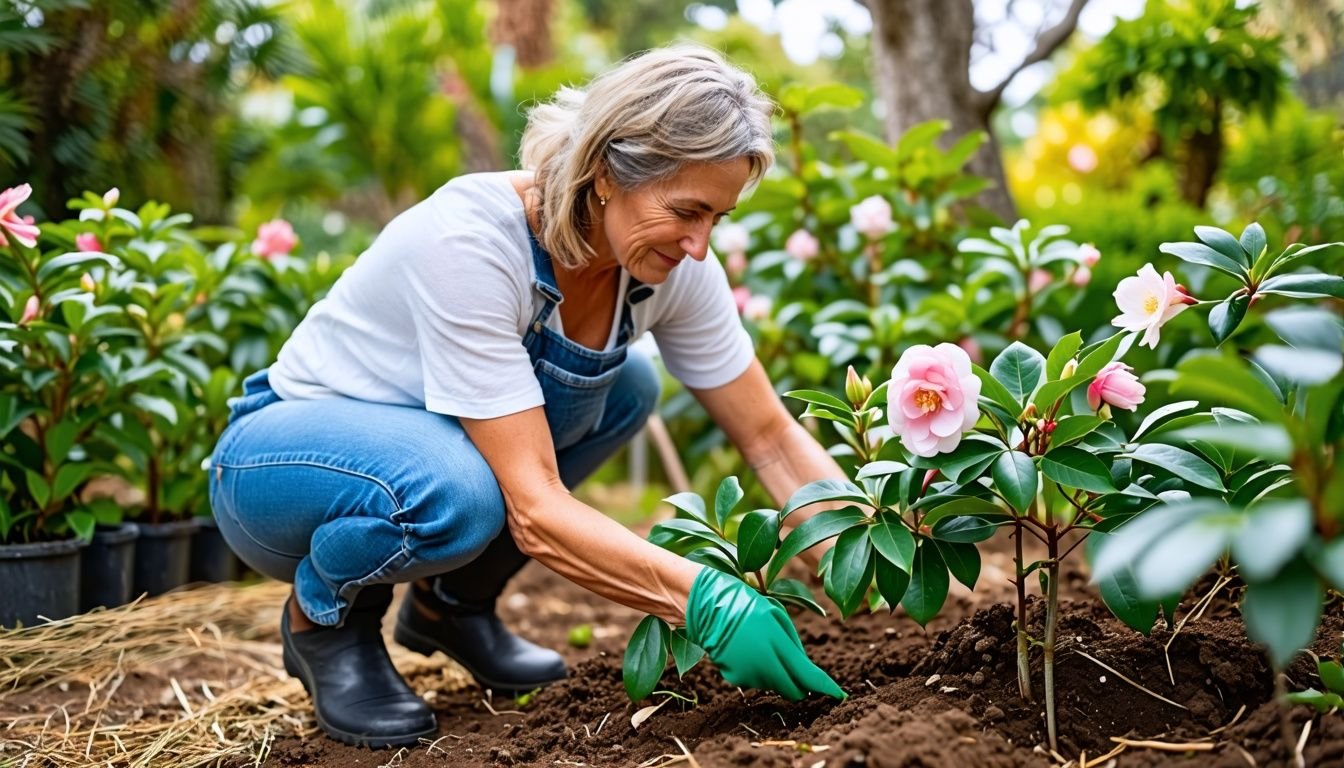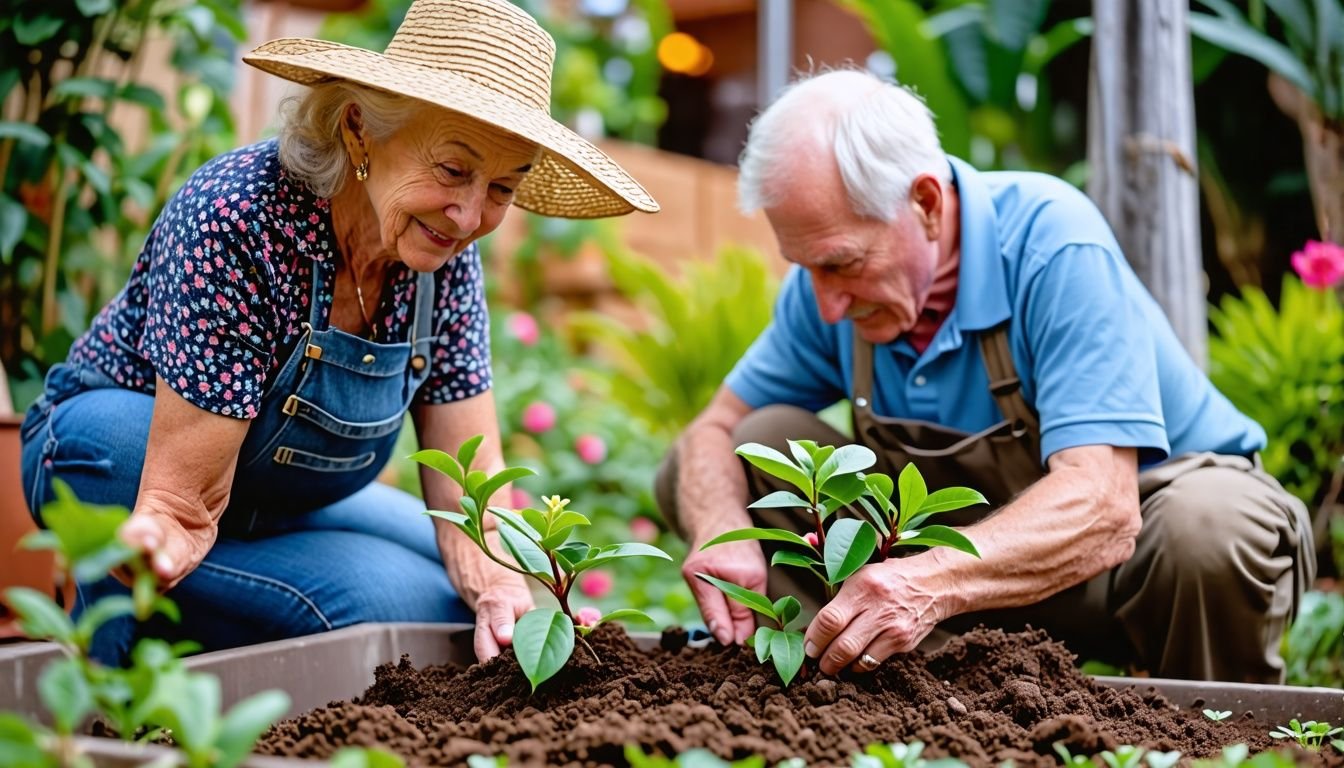G’day, fellow Aussie gardeners! If you’ve been struggling to grow small leaf camellias in our sunburnt country, you’re not alone. These little beauties can be a bit finicky with our harsh climate and unique soil.
It’s enough to make you want to chuck in the towel when you see your camellias looking worse for wear despite your best efforts.
But don’t worry, mate – we’ve been there and done that. After years of mucking about and hitting the books, we’ve finally sorted it out. And some of these camellias smell absolutely bonzer! Our guide will walk you through picking the right varieties, setting up top-notch growing conditions, and keeping your plants happy as Larry all year round.
So roll up your sleeves and get ready to give your garden a fair dinkum makeover with these gorgeous compact shrubs. You’ll be the envy of the neighbourhood in no time!
Key Takeaways
- Small leaf camellias thrive in well-draining, slightly acidic soil with a pH of 6.0 to 6.5 for most varieties.
- These plants prefer spots with morning sun and afternoon shade, protected from harsh winds and frost.
- Prune camellias after flowering ends in late spring or early summer, removing about one-third of the oldest wood yearly.
- Water deeply once a week during dry spells, increasing to twice weekly in hot summer months, and feed with slow-release, acid-loving fertiliser in early spring and late spring.
- Common issues include scale insects, petal blight, and root rot; prevent these through proper care, good air circulation, and avoiding overwatering.
Optimal Planting Conditions for Small Leaf Camellias

Small leaf camellias thrive in specific conditions. We’ll explore the best soil types, pH levels, and climate factors for these plants in Australian gardens.
Soil type and pH preferences
Small leaf camellias thrive in specific soil conditions. We’ve found that well-draining soil rich in organic matter is ideal for these plants. The pH level plays a crucial role in their growth and health.
Most small leaf camellias prefer slightly acidic soil with a pH range of 6.0 to 6.5.
Different camellia types have varying soil preferences. Sasanquas do best in soil with a pH of 6.0 to 6.5, while japonicas can handle a broader range of 5.5 to 6.5. Reticulatas and hybrids also favour slightly acidic soil.
We’ve noticed that camellias planted in the right soil bloom more profusely and resist pests better.
The right soil is the foundation of a healthy camellia garden.
For Australian gardeners, improving heavy clay soils is often necessary. We recommend mixing in organic matter or using raised beds to create the perfect growing environment. The next step in camellia care involves choosing the ideal planting location.
Ideal climate and exposure
We find that small leaf camellias thrive in Australia’s mild climates. These plants love areas with cool winters and warm summers. In most parts of our country, they grow well in spots that get morning sun and afternoon shade.
This mix gives them the light they need without scorching their leaves.
Our camellias do best when we shield them from harsh winds and frost. A spot near a north-facing wall often works well. It protects them and gives them the right amount of warmth. We’ve seen great success with camellias in coastal areas too.
The sea air seems to agree with them, as long as they’re not hit directly by salt spray.
At the Royal Botanic Gardens Victoria, we’ve cared for camellias for over 145 years. Our collection boasts more than 950 types. This long history has taught us that these plants adapt well to many Australian gardens.
With the right spot, even gardeners in hotter areas can grow these lovely plants. We just need to give them a bit more shade and water in those places.
Essential Maintenance Practices
Caring for small leaf camellias needs regular upkeep. We’ll show you how to prune, water, and feed these plants to keep them healthy and blooming.
Pruning techniques for size control
We love small leaf camellias for their compact shape and abundance of small flowers. Pruning keeps these beauties in check and promotes healthy growth.
- Timing matters: Prune after flowering ends, usually in late spring or early summer. This gives new growth time to harden before winter frosts.
- Tools of the trade: Use clean, sharp secateurs for small branches and loppers for thicker ones. This prevents damage and disease spread.
- Shape with care: Cut back long, straggly branches to maintain a rounded form. Remove about one-third of the oldest wood each year to encourage new growth.
- Thin out crowded areas: Improve air flow by removing crossed or rubbing branches. This helps prevent fungal issues common in humid Aussie climates.
- Height control: For dwarf camellias, trim the top growth to keep them at the desired height. Cut just above an outward-facing bud to promote a fuller shape.
- Rejuvenation pruning: For older, overgrown plants, cut back hard to about 60 cm from the ground. This drastic method works well for tough camellia japonicas.
- Clean up: Remove all prunings from the base of the plant. Left behind, they can harbour pests and diseases that harm your camellia.
- Post-pruning care: Apply a layer of organic mulch around the base after pruning. This helps retain moisture and feeds the acid-loving root system.
Watering and fertilisation schedules
Small leaf camellias need regular care to thrive in Australian gardens. We’ve put together a simple guide for watering and feeding these lovely plants.
- Watering routine:
- Water deeply once a week during dry spells
- Increase to twice weekly in hot summer months
- Reduce watering in winter when plants are dormant
- Use a soaker hose or drip system for even moisture
- Soil moisture check:
- Stick your finger 5 cm into the soil near the plant
- If it feels dry, it’s time to water
- Avoid overwatering, as camellias hate wet feet
- Mulching for moisture retention:
- Apply a 5-7 cm layer of organic mulch around the base
- Keep mulch away from the trunk to prevent rot
- Top up mulch yearly to maintain moisture levels
- Fertiliser schedule:
- Feed plants in early spring as new growth begins
- Use a slow-release, acid-loving plant food
- Apply again in late spring after flowering ends
- Avoid fertilising in late summer or autumn
- pH management:
- Test soil pH yearly with a home kit
- Aim for a slightly acidic range of 5.5 to 6.5
- Add sulphur to lower pH if needed
- Use lime to raise pH if it’s too low
- Foliar feeding:
- Spray leaves with liquid seaweed solution monthly
- Apply in early morning or late evening
- Avoid spraying during hot, sunny weather
- Winter care:
- Reduce watering to once every 2-3 weeks
- Stop fertilising until spring growth resumes
- Monitor for frost damage and protect if needed
Common Challenges and Solutions
Small leaf camellias face unique challenges in Australian gardens. Pests, diseases, and climate stress can harm these plants, but we have solutions to keep them healthy.
Managing pests and diseases specific to small leaf camellias
Small leaf camellias face unique challenges in Australian gardens. We’ll guide you through managing pests and diseases to keep your plants healthy.
- Scale insects: These tiny pests often attach to camellia stems and leaves. We remove them by gently scrubbing with a soft brush dipped in soapy water. For severe cases, we apply horticultural oil.
- Tea scale: This pest loves camellias. We spot it by looking for yellowing leaves with brown spots underneath. Neem oil sprays work well to control tea scale populations.
- Petal blight: This fungal disease causes brown spots on flowers. We prevent it by removing fallen blooms and avoiding overhead watering. In humid areas, we apply fungicide before buds open.
- Root rot: Poorly drained soil leads to this issue. We ensure proper drainage and avoid overwatering. If spotted, we trim affected roots and repot in fresh, well-draining potting mix.
- Leaf gall: This fungal problem causes leaf distortion. We remove and destroy affected leaves promptly. Good air circulation helps prevent leaf gall.
- Camellia yellow mottle virus: This incurable disease causes yellow leaf patterns. We remove and destroy infected plants to prevent spread. Using clean tools between plants is crucial.
- Aphids: These tiny insects cluster on new growth. We blast them off with a strong water spray or use insecticidal soap for larger infestations.
- Spider mites: These pests thrive in hot, dry conditions. We increase humidity by misting leaves and apply insecticidal soap if needed.
Proper care keeps small leaf camellias robust against most issues. Next, we’ll wrap up with key points for successful camellia growing in Australia.
Addressing climate-related stress factors
Climate stress can hit our small leaf camellias hard in Australia. We need to shield these beauties from harsh sun and hot winds. Mulching helps keep roots cool and moist. We also use shade cloth or plant them near taller plants for protection.
During heatwaves, we water deeply in the early morning or evening.
Frost poses another threat to our camellias. We cover plants with frost cloth on cold nights. For potted camellias, we move them to sheltered spots when frost looms. Good drainage is key to prevent root rot in wet winters.
We mix sand or perlite into our soil to boost drainage.
A well-cared for camellia can withstand nature’s challenges and reward us with stunning blooms.
Conclusion
We’ve examined small leaf camellias in Australia. These resilient plants provide beauty and versatility for Aussie gardens. With proper care, they flourish in our diverse climate. Selecting the right spot, soil, and care routine is essential.
Your efforts will yield stunning blooms and lush foliage. Small leaf camellias can become a treasured part of your garden for years to come.
FAQs
1. What conditions do small leaf camellias need to thrive in Australian gardens?
Small leaf camellias, like the camellia dwarf variety, prefer part shade or dappled sunlight. They grow best in acidic soil with good drainage. These woody shrubs need protection from harsh afternoon sun and strong winds. Regular watering and mulching help keep their roots cool and moist.
2. How do I plant and care for white camellia cultivars?
Plant white camellia cultivars in rich, well-draining top soil. Dig a hole twice the size of the root ball and mix in organic matter. Water deeply after planting. Prune lightly to shape the plant and remove dead wood. Feed with a fertiliser for acid-loving plants in spring and autumn.
3. Can small leaf camellias grow in full sun in Australia?
While small leaf camellias prefer part shade, some cultivars can tolerate full sun if given proper care. Choose sun-tolerant varieties and provide extra water and mulch. Morning sun with afternoon shade is ideal. In hotter regions, more shade is necessary to prevent leaf scorch.
4. What are common pests and diseases affecting small leaf camellias in Australian gardens?
Scale insects and spider mites often trouble small leaf camellias. Tea scale can cause yellowing leaves. Petal blight and root rot may occur in wet conditions. Good air circulation and proper watering help prevent fungal issues. Regular checks and prompt treatment keep these problems at bay.
